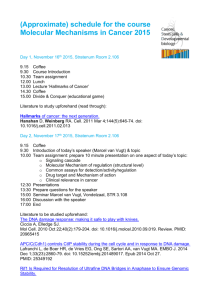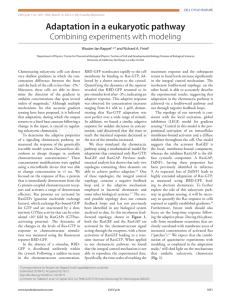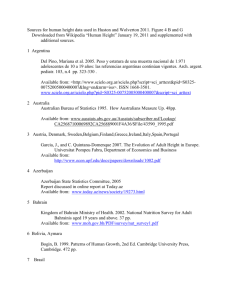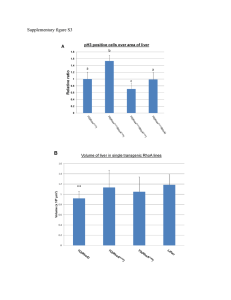V distribute. GEF-H1 Orchestrating the interplay between cytoskeleton and vesicle trafficking
advertisement
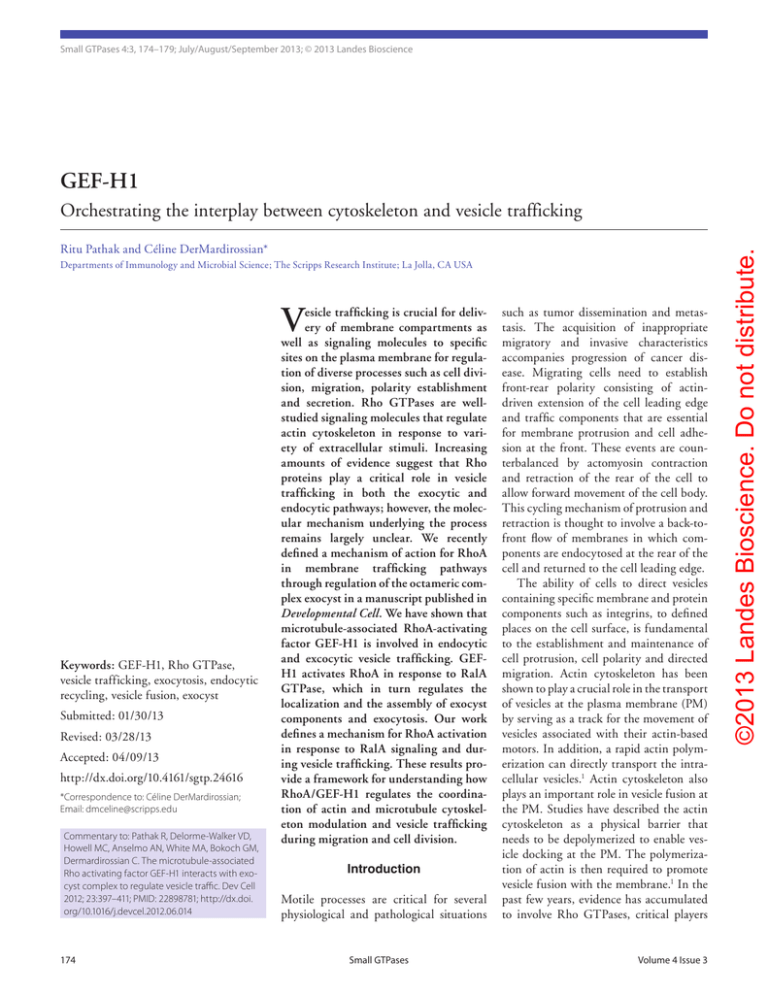
COMMENTARY Small GTPases 4:3, 174–179; July/August/September 2013; © 2013 Landes Bioscience GEF-H1 Ritu Pathak and Céline DerMardirossian* Departments of Immunology and Microbial Science; The Scripps Research Institute; La Jolla, CA USA V Keywords: GEF-H1, Rho GTPase, vesicle trafficking, exocytosis, endocytic recycling, vesicle fusion, exocyst Submitted: 01/30/13 Revised: 03/28/13 Accepted: 04/09/13 http://dx.doi.org/10.4161/sgtp.24616 *Correspondence to: Céline DerMardirossian; Email: dmceline@scripps.edu Commentary to: Pathak R, Delorme-Walker VD, Howell MC, Anselmo AN, White MA, Bokoch GM, Dermardirossian C. The microtubule-associated Rho activating factor GEF-H1 interacts with exocyst complex to regulate vesicle traffic. Dev Cell 2012; 23:397–411; PMID: 22898781; http://dx.doi. org/10.1016/j.devcel.2012.06.014 174 esicle trafficking is crucial for delivery of membrane compartments as well as signaling molecules to specific sites on the plasma membrane for regulation of diverse processes such as cell division, migration, polarity establishment and secretion. Rho GTPases are wellstudied signaling molecules that regulate actin cytoskeleton in response to variety of extracellular stimuli. Increasing amounts of evidence suggest that Rho proteins play a critical role in vesicle trafficking in both the exocytic and endocytic pathways; however, the molecular mechanism underlying the process remains largely unclear. We recently defined a mechanism of action for RhoA in membrane trafficking pathways through regulation of the octameric complex exocyst in a manuscript published in Developmental Cell. We have shown that microtubule-associated RhoA-activating factor GEF-H1 is involved in endocytic and excocytic vesicle trafficking. GEFH1 activates RhoA in response to RalA GTPase, which in turn regulates the localization and the assembly of exocyst components and exocytosis. Our work defines a mechanism for RhoA activation in response to RalA signaling and during vesicle trafficking. These results provide a framework for understanding how RhoA/GEF-H1 regulates the coordination of actin and microtubule cytoskeleton modulation and vesicle trafficking during migration and cell division. Introduction Motile processes are critical for several physiological and pathological situations Small GTPases such as tumor dissemination and metastasis. The acquisition of inappropriate migratory and invasive characteristics accompanies progression of cancer disease. Migrating cells need to establish front-rear polarity consisting of actindriven extension of the cell leading edge and traffic components that are essential for membrane protrusion and cell adhesion at the front. These events are counterbalanced by actomyosin contraction and retraction of the rear of the cell to allow forward movement of the cell body. This cycling mechanism of protrusion and retraction is thought to involve a back-tofront flow of membranes in which components are endocytosed at the rear of the cell and returned to the cell leading edge. The ability of cells to direct vesicles containing specific membrane and protein components such as integrins, to defined places on the cell surface, is fundamental to the establishment and maintenance of cell protrusion, cell polarity and directed migration. Actin cytoskeleton has been shown to play a crucial role in the transport of vesicles at the plasma membrane (PM) by serving as a track for the movement of vesicles associated with their actin-based motors. In addition, a rapid actin polymerization can directly transport the intracellular vesicles.1 Actin cytoskeleton also plays an important role in vesicle fusion at the PM. Studies have described the actin cytoskeleton as a physical barrier that needs to be depolymerized to enable vesicle docking at the PM. The polymerization of actin is then required to promote vesicle fusion with the membrane.1 In the past few years, evidence has accumulated to involve Rho GTPases, critical players Volume 4 Issue 3 ©2013 Landes Bioscience. Do not distribute. Orchestrating the interplay between cytoskeleton and vesicle trafficking COMMENTARY of actin dynamics, in regulating both the endocytic and exocytic pathways. Indeed, Rac and Cdc42 positively regulate the membrane internalization process of pinocytosis and phagocytosis.2-4 Rho family members play a key role in clathrindependent and independent endocytic processes, and also in vesicle intracellular trafficking to the appropriate endocytic sub-compartments.5,6 Moreover, Cdc42 that localizes to the golgi apparatus promotes the targeting of secretory vesicles to the cell surface.7-9 Studies have also shown that Rho and Rac are critical in the release of secretory granules by adrenal chromaffin, mast and neuronal cells.10-12 Though Rho GTPases are the master players of actin cytoskeleton and membrane trafficking, their role in controlling vesicle fusion has remained largely mysterious. Vesicle fusion is a complex process that involves the vesicles tethering, docking and priming before SNARE-mediated fusion at the PM. In response to specific extracellular cues, the membrane delivery in many cell types is regulated by an evolutionarily conserved protein complex, termed “exocyst,” which comprises eight proteins: Sec3, 5, 6, 8, 10, 15 and Exo70 and 84.13-15 The exocyst functions to target and tether secretory vesicles to specific sites of dynamic PM domains, including the leading edge of migrating cells.16 Exocyst function is regulated by small GTPases of Arf, Rab and Ral families. In mammalian systems, although known to be involved in membrane trafficking, the role of Rho GTPases in exocyst-mediated vesicle targeting is not very clear.17,18 The localized activation of Rho GTPases is a key event for the spatiotemporal regulation of cell motility. Studies using live cell biosensors have established that Rac1 activation is prominent at the cell edge19 whereas Rho activity has been shown to mediate not only the tail detachment and retraction,20 but also cell migration and the cell leading edge actin dynamics.21,22 The mechanisms controlling localized Rho activation are likely to be crucial for cell migration but are still poorly understood. Guanine nucleotide exchange factors (GEFs), which promote the exchange of GDP for GTP, are perfect candidates to ensure localized and timely activation of GTPases. GEF-H1 www.landesbioscience.com is a microtubule-associated Rho GEF23 that couples microtubule dynamics to cell contractility.24 A previous study established that its release upon microtubule depolymerization stimulates nucleotide exchange by RhoA.24 In contrast, reassociation of GEF-H1 with microtubules inhibits its enzymatic activity. The control of GEF-H1 activity by microtubule association provides a mechanism for the modulation of Rho activity in response to changes in microtubule dynamics. Indeed, the regulated release of GEF-H1 from microtubules represents a recurring mechanistic principle to achieve localized activation of RhoA.23 Changes in both the integrity of the microtubule cytoskeleton and Rho signaling are observed in numerous biological/pathophysiological conditions in which GEF-H1 has been implicated, including epithelial barrier permeability, cytokinesis, antigen presentation, dendritic spine morphology and cell motility.23,25 Recently, our group has demonstrated that the loss of GEF-H1 in cells induces aberrant cleavage furrow formation resulting in a defect of cytokinesis.26 In addition, we observed changes in cortical behavior and an accumulation of vesicles at the cleavage furrow. These observations suggested that GEF-H1 might regulate actin dynamics and modulate trafficking of membrane-containing vesicles to the cleavage furrow (a process known to be important for normal cell division 27). The vesicles accumulated in GEF-H1depleted cells varied in size and morphology suggesting that the loss of GEF-H1 might affect more than one trafficking pathway. The appearance of large vesicles after 72 hr of GEF-H1 knockdown was particularly intriguing. It is possible that these vesicles are formed by fusion among the aggregating vesicle population in absence of fusion at the PM. The phenotype was rescued by wild-type but not by dominant negative GEF-H1. Therefore, these results led us to hypothesize that GEF-H1, and subsequently Rho, play important roles in vesicle trafficking. We suggest that GEF-H1/Rho pathway coordinates cytoskeleton dynamics and membrane trafficking to influence the protrusion/retraction events at the edge of migrating cell. Small GTPases GEF-H1 Regulates Membrane Trafficking via Exocyst A more detailed analysis revealed that the depletion of GEF-H1 disrupts the endocytic recycling pathway, which targets the internalized PM components back to the surface via the perinuclear endocytic recycling compartment. Indeed, the loss of GEF-H1 in cells impaired the localization of Rab11, a small GTPase regulating both the recycling endosomes and the post-golgi secretory vesicles,28,29 and led to the accumulation of vesicles carrying transferrin receptors at the PM with a delay in recycling of this receptor. In addition, the loss of GEF-H1 also induced a defect in the insertion of GFP-VSV-G, a secretory protein, at the PM. This event was rescued by wild-type or constitutively active GEF-H1. Therefore, these data support the idea that GEF-H1 might play a critical role in vesicle trafficking and/or vesicle fusion at the PM. Since the defect in GEF-H1 activity induced the disruption of both endocytic recycling and exocytosis, we suggest that this might affect the later stages of membrane trafficking. The exocyst complex plays a crucial role in tethering and fusion of vesicles at the PM and disruption of its function leads to a defect in secretion and in vesicle accumulation.16,30 Therefore, we investigated the possibility that a defect in vesicle trafficking in the absence of GEF-H1 could be associated with exocyst function. The loss of GEF-H1 impaired Exo70 and Sec8 membrane localization and increased the aggregation of Exo70 positive vesicles. Studies done in yeast suggest that the formation of a complex between exocyst components present on vesicles with the constituents on the PM is partially responsible for directing vesicle traffic.31 In fact, Exo70 is known to localize at the PM as well as at the vesicles32 and serve as a landmark at the membrane for guiding other exocyst proteins to specific sites at the surface.33 Interestingly, we observed a decrease in the interaction between Exo70 and Sec8 in cells expressing dominant negative GEF-H1 whereas constitutively active GEF-H1 increased this binding. Thus, our results demonstrate that GEFH1 regulates exocyst function by affecting the localization of exocyst proteins to 175 ©2013 Landes Bioscience. Do not distribute. COMMENTARY RhoA Regulates Exocyst Function Small GTPases of the Rho, Arf and Ral families have been implicated as important spatio-temporal regulators of membrane trafficking events by the exocyst complex.30,35,36 However, the mechanism(s) by which mammalian Rho GTPases regulate exocyst function remain poorly defined. The effect of GEFH1 ablation in cells on exocyst complex prompted us to determine whether GEFH1 binds to exocyst proteins. We found a direct interaction between GEF-H1 and exocyst subunit Sec5. This binding was crucial for the role of GEF-H1 in vesicle trafficking. Indeed, the disruption of this interaction using a peptide fragment of GEF-H1 involved in the binding with Sec5, led to a defect in exocytic vesicle trafficking similar to what we observed for GEF-H1 depletion. This effect is most likely not dependent on the role of GEFH1 in regulating actin cytoskeleton since we did not observe any changes in cytoskeleton morphology. To explore the physiological relevance of this interaction, we examined the binding in the context of Ral GTPases that might influence the association between GEF-H1 and exocyst, and subsequently, the membrane traffic. Active Ral GTPases regulate the assembly of exocyst complex during vesicle tethering by a direct binding with two distinct subunits, Sec5 and Exo84.35,37,38 Studies have demonstrated that Ral relieves the auto-inhibition within Sec5 facilitating its interaction with the other exocyst proteins and effectors.39 We found that the binding between Sec5 and GEF-H1 was increased in cells overexpressing wild-type, constitutively active (G23V), or fast-cycling active (F39L) RalA. 176 To assess the biological role of RalASec5-GEF-H1 interaction, we characterized the consequences on GEF-H1 activity by examining the effect of RalA on RhoA activation using a Rhotekin RBD (Rho-binding domain) pull-down assay. Intriguingly, our results indicated that RalA 38R, a mutant that cannot interact with Sec5 but with Exo84, was not able to mediate RhoA activation. In contrast, RalA48W that can interact with Sec5 but not with Exo84 facilitated RhoA activation. Furthermore, the presence of GEF-H1 and its interaction with Sec5 was imperative for RhoA activation by RalA. We also observed an interaction between GEF-H1 and Sec5 in presence of RalB, another Ral family GTPase (unpublished result). Though RalA and RalB are 80% identical and in some cases, work redundantly, they also perform distinct functions in cells. RalA is involved in epithelial cell polarity, Glut4 translocation, insulin secretion by pancreatic islet β cells, neurite branching and neuronal polarity. RalB, on the other hand, is involved in tumor cell survival, migration and invasion, and autophagy.40 It will be interesting to investigate the impact of RalB on RhoA activation and whether the GEF-H1/RhoA signaling pathway mediates some of the effects of RalB in cells. RalA-Sec5-GEF-H1 mediated activation of RhoA prompted us to investigate the role of RhoA in exocyst function. We found that RhoAwt enhanced the interaction between Exo70 and Sec8 suggesting that RhoA is, most likely, activated by GEF-H1 to affect the exocyst assembly and/or maintenance. We did not observe an increase in the complex formation between Sec8 and Exo70 in presence of constitutively active RhoA, suggesting that the catalytic cycle of RhoA is crucial for its function. We also observed an accumulation of Exo70-positive vesicles in RhoA and B-depleted cells, similar to GEF-H1 ablation, resulting in a defect in insertion of the secretory protein, GFPVSV-G, at the PM. Thus, we conclude that RhoA (and RhoB to a lesser extent) regulates exocyst function and exocytic membrane trafficking. It is possible that the exocyst complex regulates cell migration by controlling the delivery of GEF-H1 to the PM and consequently promoting the Small GTPases activation of RhoA and RhoA-mediated migration pathways. Conclusion and Future Directions We have identified a new mechanism for RhoA activation and a role for GEFH1/RhoA signaling pathway in membrane trafficking. Our study may have a profound impact on understanding the role of GEF-H1/RhoA in cell migration and cytokinesis, but also on how RhoA regulates secretion in various systems. The effect of RhoA on exocytosis varies based on the cell type. In neuroendocrine chromaffin cells and PC12 cells, RhoA has been shown to play a negative role,10,41 while in mast cells, RhoA positively regulates exocytosis.11,42 In chromaffin cells, RhoA localizes to the secretory vesicles and regulates phosphatidylinositol 4-kinase activity to generate phosphatidylinositol 4 phosphate43 which is a precursor for PIP2 that can polymerize actin cytoskeleton and strengthen the cytoskeleton-membrane association.44 It has been proposed that this mechanism would allow for a localized increase in PIP2 concentration near the vesicles that stabilizes the actin network to prevent vesicle fusion. Upon stimulation, RhoA would be inactivated, the actin cytoskeleton dismantled, and vesicles would be free to undergo fusion. It is possible that in this scenario RhoA could have a twopronged role: Before stimulation, it could be responsible for holding the vesicles in place, and then post-stimulation, it could facilitate vesicle fusion through the regulation of exocyst function. Therefore, the role of GEF-H1 in timely activation of RhoA could be important for the process. Whether GEF-H1 localizes to vesicles is not clear at present; however, it could interact with vesicles directly through a PH domain and/or through its interaction with the exocyst complex. Since exocyst proteins form distinct sub-complexes and the interaction between these complexes are crucial for membrane targeting,45 it will be very interesting to examine the association of GEF-H1 with the secretory vesicles and its effect on the exocyst machinery distribution, which can be assessed now due to the availability of antibodies for all the exocyst components. Volume 4 Issue 3 ©2013 Landes Bioscience. Do not distribute. the PM and the complex assembly and/or stability. In addition, recent studies have shown that Exo70 affects cell motility by interacting with the Arp2/3 complex, a key regulator of actin polymerization.34 These studies combined with our results suggest that the defect in cell migration and leading edge dynamics in GEF-H1depleted cells might be partially explained by the impairment in the localization of Exo70. RhoA coordinates the modulation of actin cytoskeleton and secretion in mast cells through parallel but independent pathways.42 The mechanism of the vesicle trafficking regulation independently of the actin cytoskeleton is not known. It is possible that RhoA-mediated regulation of exocyst localization and assembly via GEF-H1 could play a role in secretion by mast cells. The impact of GEF-H1 and RhoA on exocyst function and membrane trafficking can be studied in various cell types by specifically disrupting the association between GEF-H1 and Sec5 by using the competing peptide described in our paper.46 Thus, GEF-H1-RhoAexocyst signaling axis could be involved www.landesbioscience.com in secretion events in various cell systems and could provide valuable information about the coordination of cytoskeletal modulation with vesicle trafficking and fusion at the PM. The involvement of RhoA in regulating exocyst function during exocytosis presents significant advance in understanding the role of RhoA in membrane trafficking. Based on our results, we propose a model (Fig. 1) to show the interplay between actin, microtubule cytoskeletons and vesicle trafficking. Microtubules serve as tracks for vesicle delivery to the fusion sites at the PM.47 Thus, since GEF-H1 is activated upon MT depolymerization and influences exocyst complex formation Small GTPases and stabilization, one could imagine that GEF-H1 is in a position to facilitate vesicle fusion at the PM. Exocyst proteins have been shown to destabilize microtubules, which can then promote PM addition.48,49 According to our data, the microtubule binding-deficient GEF-H1 variant showed high in vivo binding to Sec5 compared with GEF-H1wt. Therefore, it is possible that Sec5 could promote the activation of GEF-H1 by either facilitating its extraction from the microtubules or capturing GEF-H1 as it comes off the microtubules. Free GEF-H1 can activate RhoA, which then regulates exocyst function. Our work brings us one step closer to understanding the molecular mechanism that operates 177 ©2013 Landes Bioscience. Do not distribute. Figure 1. A putative model for the regulation of membrane trafficking by GEF-H1/RhoA pathway. (A) Vesicles carrying exocyst components, and possibly RhoA, are targeted to specific sites marked by Exo70 at the PM using microtubules as tracks. (B) GEF-H1 associated with microtubules is inactive. Upon microtubule depolymerization, GEF-H1 is released and then binds directly with the exocyst component Sec5. (C) The interaction between exocyst and GEF-H1 leads to RhoA activation in the vicinity of vesicles. (D) RhoA in turn regulates the exocyst function by affecting the complex formation which then promotes the fusion of vesicles. Disclosure of Potential Conflicts of Interest No potential conflicts of interest were disclosed. References 1. Eitzen G. Actin remodeling to facilitate membrane fusion. Biochim Biophys Acta 2003; 1641:175-81; PMID:12914958; http://dx.doi.org/10.1016/S01674889(03)00087-9 2. Ridley AJ, Paterson HF, Johnston CL, Diekmann D, Hall A. The small GTP-binding protein rac regulates growth factor-induced membrane ruffling. Cell 1992; 70:401-10; PMID:1643658; http://dx.doi. org/10.1016/0092-8674(92)90164-8 3. Dharmawardhane S, Schürmann A, Sells MA, Chernoff J, Schmid SL, Bokoch GM. Regulation of macropinocytosis by p21-activated kinase-1. Mol Biol Cell 2000; 11:3341-52; PMID:11029040 4. Chimini G, Chavrier P. Function of Rho family proteins in actin dynamics during phagocytosis and engulfment. Nat Cell Biol 2000; 2:E191-6 ; PMID:11025683; http://dx.doi. org/10.1038/35036454 5. Qualmann B, Mellor H. Regulation of endocytic traffic by Rho GTPases. Biochem J 2003; 371:23341; PMID:12564953; http://dx.doi.org/10.1042/ BJ20030139 6. Mayor S, Pagano RE. Pathways of clathrinindependent endocytosis. Nat Rev Mol Cell Biol 2007; 8:603-12; PMID:17609668; http://dx.doi. org/10.1038/nrm2216 7. Hong-Geller E, Cerione RA. Cdc42 and Rac stimulate exocytosis of secretory granules by activating the IP(3)/calcium pathway in RBL-2H3 mast cells. J Cell Biol 2000; 148:481-94; PMID:10662774; http:// dx.doi.org/10.1083/jcb.148.3.481 8. Brown AM, O’Sullivan AJ, Gomperts BD. Induction of exocytosis from permeabilized mast cells by the guanosine triphosphatases Rac and Cdc42. Mol Biol Cell 1998; 9:1053-63; PMID:9571239 9. Kroschewski R, Hall A, Mellman I. Cdc42 controls secretory and endocytic transport to the basolateral plasma membrane of MDCK cells. Nat Cell Biol 1999; 1:8-13; PMID:10559857 10. Gasman S, Chasserot-Golaz S, Bader MF, Vitale N. Regulation of exocytosis in adrenal chromaffin cells: focus on ARF and Rho GTPases. Cell Signal 2003; 15:893-9; PMID:12873702; http://dx.doi. org/10.1016/S0898-6568(03)00052-4 11. Price LS, Norman JC, Ridley AJ, Koffer A. The small GTPases Rac and Rho as regulators of secretion in mast cells. Curr Biol 1995; 5:68-73; PMID:7697350; http://dx.doi.org/10.1016/S0960-9822(95)00018-2 12. Doussau F, Augustine GJ. The actin cytoskeleton and neurotransmitter release: an overview. Biochimie 2000; 82:353-63; PMID:10865123; http://dx.doi. org/10.1016/S0300-9084(00)00217-0 13. Guo W, Roth D, Walch-Solimena C, Novick P. The exocyst is an effector for Sec4p, targeting secretory vesicles to sites of exocytosis. EMBO J 1999; 18:1071-80; PMID:10022848; http://dx.doi. org/10.1093/emboj/18.4.1071 14. Kee Y, Yoo JS, Hazuka CD, Peterson KE, Hsu SC, Scheller RH. Subunit structure of the mammalian exocyst complex. Proc Natl Acad Sci U S A 1997; 94:14438-43; PMID:9405631; http://dx.doi. org/10.1073/pnas.94.26.14438 15. TerBush DR, Maurice T, Roth D, Novick P. The Exocyst is a multiprotein complex required for exocytosis in Saccharomyces cerevisiae. EMBO J 1996; 15:6483-94; PMID:8978675 178 16. He B, Guo W. The exocyst complex in polarized exocytosis. Curr Opin Cell Biol 2009; 21:53742; PMID:19473826; http://dx.doi.org/10.1016/j. ceb.2009.04.007 17. Prigent M, Dubois T, Raposo G, Derrien V, Tenza D, Rossé C, et al. ARF6 controls post-endocytic recycling through its downstream exocyst complex effector. J Cell Biol 2003; 163:1111-21; PMID:14662749; http://dx.doi.org/10.1083/jcb.200305029 18. Novick P, Guo W. Ras family therapy: Rab, Rho and Ral talk to the exocyst. Trends Cell Biol 2002; 12:247-9; PMID:12074877; http://dx.doi. org/10.1016/S0962-8924(02)02293-6 19. Kraynov VS, Chamberlain C, Bokoch GM, Schwartz MA, Slabaugh S, Hahn KM. Localized Rac activation dynamics visualized in living cells. Science 2000; 290:333-7; PMID:11030651; http://dx.doi. org/10.1126/science.290.5490.333 20. Burridge K, Doughman R. Front and back by Rho and Rac. Nat Cell Biol 2006; 8:781-2; PMID:16880807; http://dx.doi.org/10.1038/ncb0806-781 21. Pertz O, Hodgson L, Klemke RL, Hahn KM. Spatiotemporal dynamics of RhoA activity in migrating cells. Nature 2006; 440:106972; PMID:16547516; http://dx.doi.org/10.1038/ nature04665 22. Machacek M, Hodgson L, Welch C, Elliott H, Pertz O, Nalbant P, et al. Coordination of Rho GTPase activities during cell protrusion. Nature 2009; 461:99-103; PMID:19693013; http://dx.doi. org/10.1038/nature08242 23. Birkenfeld J, Nalbant P, Yoon SH, Bokoch GM. Cellular functions of GEF-H1, a microtubule-regulated Rho-GEF: is altered GEF-H1 activity a crucial determinant of disease pathogenesis? Trends Cell Biol 2008; 18:210-9; PMID:18394899; http://dx.doi. org/10.1016/j.tcb.2008.02.006 24. Krendel M, Zenke FT, Bokoch GM. Nucleotide exchange factor GEF-H1 mediates cross-talk between microtubules and the actin cytoskeleton. Nat Cell Biol 2002; 4:294-301; PMID:11912491; http:// dx.doi.org/10.1038/ncb773 25. Nalbant P, Chang YC, Birkenfeld J, Chang ZF, Bokoch GM. Guanine nucleotide exchange factorH1 regulates cell migration via localized activation of RhoA at the leading edge. Mol Biol Cell 2009; 20:4070-82; PMID:19625450; http://dx.doi. org/10.1091/mbc.E09-01-0041 26. Birkenfeld J, Nalbant P, Bohl BP, Pertz O, Hahn KM, Bokoch GM. GEF-H1 modulates localized RhoA activation during cytokinesis under the control of mitotic kinases. Dev Cell 2007; 12:699-712; PMID:17488622; http://dx.doi.org/10.1016/j.devcel.2007.03.014 27. Prekeris R, Gould GW. Breaking up is hard to do - membrane traffic in cytokinesis. J Cell Sci 2008; 121:1569-76; PMID:18469013; http://dx.doi. org/10.1242/jcs.018770 28. Ullrich O, Reinsch S, Urbé S, Zerial M, Parton RG. Rab11 regulates recycling through the pericentriolar recycling endosome. J Cell Biol 1996; 135:91324; PMID:8922376; http://dx.doi.org/10.1083/ jcb.135.4.913 29. Urbé S, Huber LA, Zerial M, Tooze SA, Parton RG. Rab11, a small GTPase associated with both constitutive and regulated secretory pathways in PC12 cells. FEBS Lett 1993; 334:175-82; PMID:8224244; http://dx.doi.org/10.1016/0014-5793(93)81707-7 30. Wu H, Rossi G, Brennwald P. The ghost in the machine: small GTPases as spatial regulators of exocytosis. Trends Cell Biol 2008; 18:397-404; PMID:18706813; http://dx.doi.org/10.1016/j. tcb.2008.06.007 31. Guo W, Sacher M, Barrowman J, Ferro-Novick S, Novick P. Protein complexes in transport vesicle targeting. Trends Cell Biol 2000; 10:251-5; PMID:10802541; http://dx.doi.org/10.1016/S09628924(00)01754-2 Small GTPases 32. Boyd C, Hughes T, Pypaert M, Novick P. Vesicles carry most exocyst subunits to exocytic sites marked by the remaining two subunits, Sec3p and Exo70p. J Cell Biol 2004; 167:889-901; PMID:15583031; http://dx.doi.org/10.1083/jcb.200408124 33. Liu J, Zuo X, Yue P, Guo W. Phosphatidylinositol 4,5-bisphosphate mediates the targeting of the exocyst to the plasma membrane for exocytosis in mammalian cells. Mol Biol Cell 2007; 18:4483-92; PMID:17761530; http://dx.doi.org/10.1091/mbc. E07-05-0461 34. Liu J, Zhao Y, Sun Y, He B, Yang C, Svitkina T, et al. Exo70 stimulates the Arp2/3 complex for lamellipodia formation and directional cell migration. Curr Biol 2012; 22:1510-5; PMID:22748316; http:// dx.doi.org/10.1016/j.cub.2012.05.055 35. Moskalenko S, Henry DO, Rosse C, Mirey G, Camonis JH, White MA. The exocyst is a Ral effector complex. Nat Cell Biol 2002; 4:66-72; PMID:11740492; http://dx.doi.org/10.1038/ncb728 36. van Dam EM, Robinson PJ. Ral: mediator of membrane trafficking. Int J Biochem Cell Biol 2006; 38:1841-7; PMID:16781882; http://dx.doi. org/10.1016/j.biocel.2006.04.006 37. Jin R, Junutula JR, Matern HT, Ervin KE, Scheller RH, Brunger AT. Exo84 and Sec5 are competitive regulatory Sec6/8 effectors to the RalA GTPase. EMBO J 2005; 24:2064-74; PMID:15920473; http://dx.doi.org/10.1038/sj.emboj.7600699 38. Sugihara K, Asano S, Tanaka K, Iwamatsu A, Okawa K, Ohta Y. The exocyst complex binds the small GTPase RalA to mediate filopodia formation. Nat Cell Biol 2002; 4:73-8; PMID:11744922; http:// dx.doi.org/10.1038/ncb720 39. Chien Y, Kim S, Bumeister R, Loo YM, Kwon SW, Johnson CL, et al. RalB GTPase-mediated activation of the IkappaB family kinase TBK1 couples innate immune signaling to tumor cell survival. Cell 2006; 127:157-70; PMID:17018283; http://dx.doi. org/10.1016/j.cell.2006.08.034 40. Peschard P, McCarthy A, Leblanc-Dominguez V, Yeo M, Guichard S, Stamp G, et al. Genetic deletion of RALA and RALB small GTPases reveals redundant functions in development and tumorigenesis. Curr Biol 2012; 22:2063-8; PMID:23063435; http:// dx.doi.org/10.1016/j.cub.2012.09.013 41. Ory S, Gasman S. Rho GTPases and exocytosis: what are the molecular links? Semin Cell Dev Biol 2011; 22:27-32; PMID:21145407; http://dx.doi. org/10.1016/j.semcdb.2010.12.002 42. Norman JC, Price LS, Ridley AJ, Koffer A. The small GTP-binding proteins, Rac and Rho, regulate cytoskeletal organization and exocytosis in mast cells by parallel pathways. Mol Biol Cell 1996; 7:1429-42; PMID:8885237 43. Gasman S, Chasserot-Golaz S, Hubert P, Aunis D, Bader MF. Identification of a potential effector pathway for the trimeric Go protein associated with secretory granules. Go stimulates a granule-bound phosphatidylinositol 4-kinase by activating RhoA in chromaffin cells. J Biol Chem 1998; 273:1691320; PMID:9642253; http://dx.doi.org/10.1074/ jbc.273.27.16913 44. Raucher D, Stauffer T, Chen W, Shen K, Guo S, York JD, et al. Phosphatidylinositol 4,5-bisphosphate functions as a second messenger that regulates cytoskeleton-plasma membrane adhesion. Cell 2000; 100:221-8; PMID:10660045; http://dx.doi. org/10.1016/S0092-8674(00)81560-3 45. Moskalenko S, Tong C, Rosse C, Mirey G, Formstecher E, Daviet L, et al. Ral GTPases regulate exocyst assembly through dual subunit interactions. J Biol Chem 2003; 278:51743-8; PMID:14525976; http://dx.doi.org/10.1074/jbc.M308702200 Volume 4 Issue 3 ©2013 Landes Bioscience. Do not distribute. at the interface of actin and microtubule cytoskeletons and membrane trafficking. 48. Wang S, Liu Y, Adamson CL, Valdez G, Guo W, Hsu SC. The mammalian exocyst, a complex required for exocytosis, inhibits tubulin polymerization. J Biol Chem 2004; 279:35958-66; PMID:15205466; http://dx.doi.org/10.1074/jbc.M313778200 49. Zakharenko S, Popov S. Dynamics of axonal microtubules regulate the topology of new membrane insertion into the growing neurites. J Cell Biol 1998; 143:1077-86; PMID:9817763; http://dx.doi. org/10.1083/jcb.143.4.1077 ©2013 Landes Bioscience. Do not distribute. 46.Pathak R, Delorme-Walker VD, Howell MC, Anselmo AN, White MA, Bokoch GM, et al. The microtubule-associated Rho activating factor GEF-H1 interacts with exocyst complex to regulate vesicle traffic. Dev Cell 2012; 23:397-411; PMID:22898781; http://dx.doi.org/10.1016/j.devcel.2012.06.014 47. Schmoranzer J, Simon SM. Role of microtubules in fusion of post-Golgi vesicles to the plasma membrane. Mol Biol Cell 2003; 14:1558-69; PMID:12686609; http://dx.doi.org/10.1091/mbc.E02-08-0500 www.landesbioscience.com Small GTPases 179
